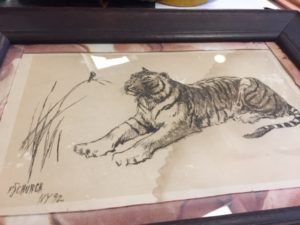 I snapped up this illustration of a tiger observing a singing bird on a branch, at Destined for Grace Thrift Store in Goleta. The signature reads “F S CHURCH.” One of my clients collects the art of Frederick Stuart Church (1842-1924); I have come to love Church’s work.
I snapped up this illustration of a tiger observing a singing bird on a branch, at Destined for Grace Thrift Store in Goleta. The signature reads “F S CHURCH.” One of my clients collects the art of Frederick Stuart Church (1842-1924); I have come to love Church’s work.
Church’s work illustrates a certain type of illustration during a fascinating period in American cultural history, The Gilded Age. FS Church, a product of his era, landed in the right place at the right time to become a great American illustrator, with the age’s sense of lightness.
Frederick Stuart Church loved and understood animals
In my lithograph, dated 1892, the bird sings, note the swelling breast. The tiger appears curious yet becalmed See the tilt of the head and outstretched paws. This tells us much about Gilded Age conflicts between the fat cats and the little innocents. I researched Church’s fondness for illustrating tigers, not normally found in New York City. Found a fellow artist’s satire of Church, A.B. Frost’s fat outstretched tiger, smoking an after dinner cigar, having eaten a big wig professor.
This illustration also tells us something about the artist himself. Most Gilded Age artists studied in Europe, in ateliers in France and Italy. Collectors perceived European art as finer than art produced in America. Church held no European education. He made no bones about his pride as an American artist. Considering the influx of European immigrants to New York City (my great grandfather one of them), ‘American’ art came into question. Church studied in the 1860’s in Chicago, thought rough and uncultured. Taught by a German educated Scottish artist, Walter Shirlaw, of The Chicago Academy of Design in 1868, Church entered in the circle of the founder of the Society of American Artists.
Frederick Stuart Church’s passion for the study of animals
Although Church lived in the heart of New York City from 1870 on, his wealthy patrons helped him paint nature. Wealthy family men of the Gilded Age invited him to paint in the farm country. One patron built him a studio on his estate in New Jersey. His passion for the study of animals became a hallmark of the artist’s oeuvre. A fine little children’s book, Aesop’s Fables of 1878, for which Church drew both humans and animals, came out of such studies.
Church spent hours sketching at the early prototype of the Public Zoo, the Central Park Menagerie, a menagerie, not a zoo, as we know it. Central Park Zoo opened in 1934. The first US public Zoo, in Philadelphia, opened in 1859. A regular at the Menagerie, opened in 1864, Church sketched the Menagerie’s collection of deer, foxes, fish, parrots, and cows, ‘donated’ when NY owners could not keep them.
Access to Exotic Animals
Traveling circuses also donated or stored animals at the Central Park Menagerie during Church’s time. In fact the 1871 P T Barnum’s Great Traveling Museum, Menagerie, Caravan, and Hippodrome, later the “Greatest Show on Earth,” kept exotic animals there. “The Greatest Show on Earth” became “Barnum and Bailey’s Circus” when two competing shows merged in 1881. The typical mode of transport was horse drawn caravans. They didn’t use trains for animals until 1884. The Central Park Menagerie was a needed stopping off point for Barnum and Bailey’s Circus.
When Church studied animals for Aesop’s Fables, he gained opportunities to get to know various exotic animals. He exhibited endless patience with his animal models, educating himself in animal anatomy as well. Studying tigers in NYC would have been impossible before this era.
The Gilded Age: gilded for some, devastating for many
A time of extensive wealth owned by very few amidst the growth of urban culture in the great US cities, Church used his animals to comment on the era. Church, keenly aware of society’s children, addressed many of his illustrations and letters to children. Children were special to Church, and others of his social class, idolized if the child was the son or daughter of a wealthy family. Yet Church developed an awareness of the precarious balance of the innocence of childhood in a big city. Thus Church became famous for his child/animal allegories. He painted animals anthropomorphically, endowing them with a human-like sense of humor, often protecting children, standing beside a little one. Church was also sensitive to plight of the female child raised in a gilded cage of the time.
The value? $250. But as a slice of cultural time: invaluable.
Is this an etching?
Have you had this long?
Do you still have it?
Best,
Bob C.
I have an original 1 of these etchings but Frederick s. Church ny 1892. Can u tell me the value range??